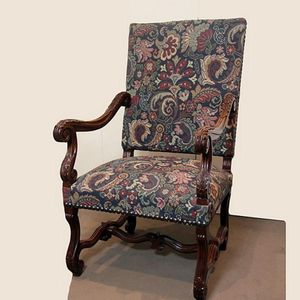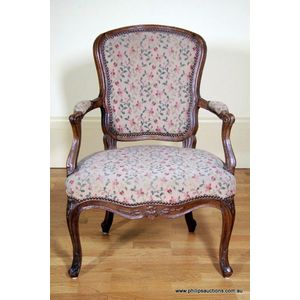Georgian Eagle Carved Settee
You must be a subscriber, and be logged in to view price and dealer details.
Subscribe Now to view actual auction price for this item
When you subscribe, you have the option of setting the currency in which to display prices to $Au, $US, $NZ or Stg.
- Rail - A term used by cabinet makers for the horizontal sections of the frame of an item such as a chair or settee which have a front rail, a back rail and two side rails, and also on a door or carcase, where the rails are joined to the vertical framings.
- The Eagle - The eagle has been a symbol of power, victory, and strength for centuries. It is often associated with bravery, prowess, and dominance, and has been used as a symbol by many cultures and civilizations throughout history.
In ancient Greece, the eagle was associated with the god Zeus, who was considered the king of the gods and the ruler of the skies. In many cultures, the eagle was seen as a messenger between the physical world and the spirit world, and was associated with the sun and the sky.
In the Roman Empire, the eagle was the symbol of the Roman army, and was displayed on the standards of the soldiers to show the power and authority of the empire. In medieval Europe, the eagle was used as a symbol of power and victory by monarchs and rulers, and was often depicted in art and architecture as a symbol of strength and courage.
In modern times, the eagle continues to be a symbol of power, victory, and strength. It is often used as a symbol by nations and organisations, and is frequently depicted in art and on monuments to commemorate important events and achievements.
The eagle's powerful appearance, combined with its association with freedom, courage, and dominance, makes it a popular and enduring symbol of power and victory. - Cabriole Leg - The cabriole leg evolved from an elongated scroll, curving out at the knee which may or may not be carved, and forming a serpentine shape as it descends to the foot.
First introduced into English furniture in the late 17th century, cabriole legs were widely used during the Queen Anne and early Georgian periods, where they frequently terminated in a pad foot or ball and claw foot. The style has had many imitators since then. The cabriole leg was re-introduced in the mid-19th century, and is commonly associated with the balloon-back dining or drawing-room chairs made in walnut, mahogany or, in Australia, cedar. The Victorian cabriole leg, on the whole, was rather more slender than the earlier form, following the French style, which emphasized the delicacy and daintiness of the chairs they were designed to support. Cabriole legs are sometimes found on windsor chairs, especially those made during the 18th century. - Serpentine - Resembling a serpent, in the form of an elongated 'S'. A serpentine front is similar to a bow front, except that the curve is shallow at each end, swelling towards the middle. The term presumably derives from its similarity to a moving snake or serpent. Serpentine fronts are usually veneered, with the carcase either being cut and shaped from a solid piece of timber, or built in the 'brick' method.
- Georgian - As an English stylistic period, Georgian is usually taken to cover the period from George I (1714) to the Regency of Prince George (1811-20), although the period from 1800 to 1830 is sometimes designated as the Regency period. During the Georgian period the great English cabinetmakers and designers such as Chippendale, Hepplewhite, Adam Sheraton etc., were all active.
Therefore there isn't a single 'Georgian style' as such and to say something is 'Georgian', usually means it was made between 1714 and 1830. This assumes we discount George V and George VI, both being from the 20th century.
The styles popular at the time of each reign were:
George I (1714-1727) saw out the last years of the Baroque period.
George II (1727-1760) reigned during the Rococo period.
George III (1760-1820) saw the last gasp of the Rococo, all of the early Neo-Classic 'Adam style' and most of the later neo-Classic 'Regency style'.
George IV (Prince Regent 1820-1830)encompassed the last of the 'Regency' style.
William IV's reign (1830-1837) was something of a no man's land (stylistically) and he wasn't a 'George' anyway. He covered the last glimmerings of 'Regency' and the start of the 'Victorian' style.
This item has been included into following indexes:
Visually similar items

French Louis XIV style oak fauteuil, with a padded back and armrests on scroll supports, with a padded seat on short turned carved legs, with carved stretcher

A late 17th century north Italian walnut chair, with embossed leather decoration, the arching padded back above a pair of scroll fluted arms, with cushion to the square seat, supported on scrolling legs joined by stretcher.

A Louis XV-style walnut fauteuil, 19th century, possibly earlier, the moulded frame decorated with carved decorative details, upholstered in close-nailed floral fabric. Height 88 cm. Width 61 cm. Depth 64 cm.

A Louis XV style 19th century fauteuil. Foliate carved cresting rail above a padded tablet back, arms and seat, raised on cabriole legs. Provenance: William Johnson, Kent Antique, High Street, Armadale
